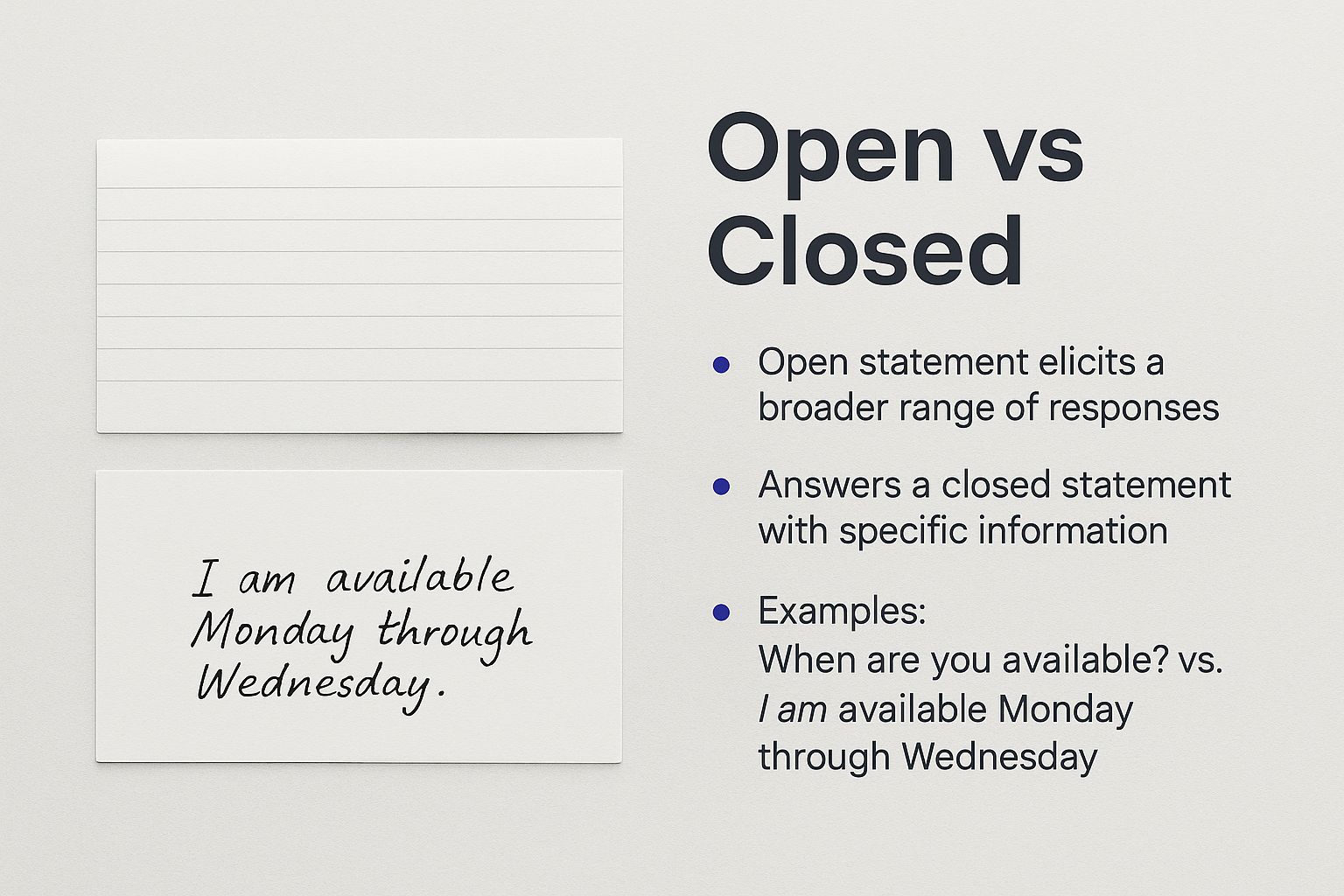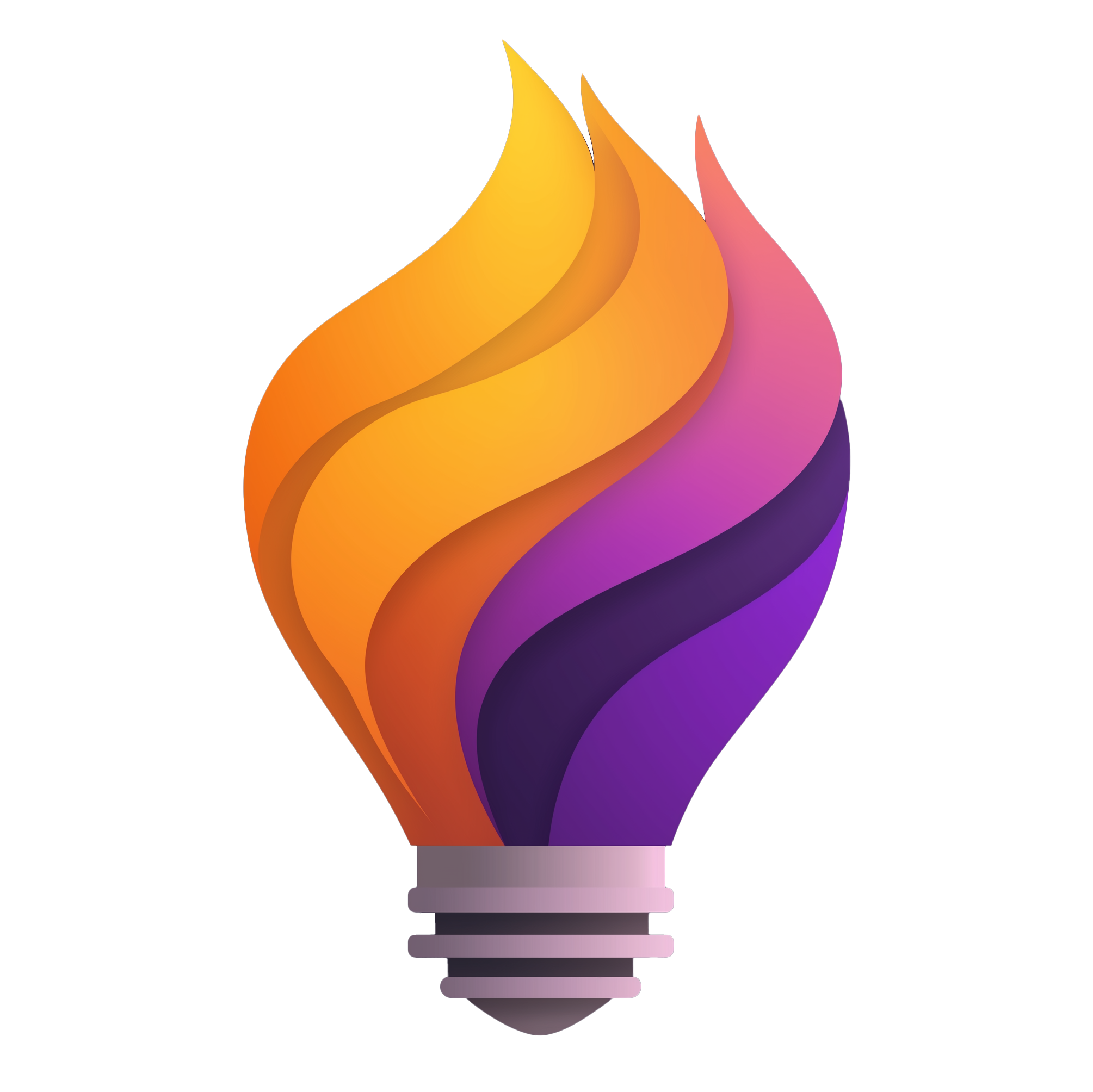Ever wonder what makes a research question truly powerful? It’s often not the one that gets a simple "yes" or "no" answer. Instead, it’s the question that cracks open a topic and invites a flood of detailed, narrative responses.
Think of it like this: a closed question is a key to a single, labeled drawer. An open-ended research question is the key that unlocks an entire room filled with stories, unexpected connections, and genuine insights. It's where real exploration begins.
What Exactly Is an Open-Ended Research Question?

At its heart, an open-ended research question is a prompt designed to get people talking. It encourages them to share their own thoughts, feelings, and experiences without being boxed in.
The difference is simple but profound. A closed question asks, "Did you like the workshop?" An open question asks, "What were your thoughts on the workshop?" See the difference? One asks for a verdict; the other starts a conversation.
This distinction is the bedrock of qualitative research, where the goal isn't just to measure things but to understand them deeply. These questions are intentionally broad, giving you a framework for discovery rather than a rigid tool for measurement.
An open-ended question is designed to start a conversation and explore possibilities. Its primary purpose is to gather rich, qualitative insights by focusing on the 'why' and 'how' behind a subject, not just the 'what.'
The Foundation of Discovery
The real magic of this questioning style is its knack for uncovering things you never expected to find. Researchers lean on open-ended questions when they need to:
- Explore new topics where they don’t even know what all the possible answers might be.
- Understand complex motivations and get the full story behind people's behaviors or opinions.
- Gather authentic feedback that isn't colored or limited by a list of pre-selected answers.
This approach is what gives research findings their depth and meaning. When you move beyond simple binary answers, you create the space for people to show you what truly matters to them. To see this in action, check out these practical samples of open-ended questions and notice how they are built for exploration.
Why These Questions Unlock Deeper Insights
An open-ended research question does more than just scratch the surface; it digs deep to uncover the all-important ‘why’ behind the numbers. While a closed question can tell you how many users clicked a button, an open-ended one reveals the story behind that click—the frustration, the curiosity, the motivation.
Think of it like this: quantitative data is the map showing you where people went. But the qualitative data you get from open questions? That’s the travel journal, filled with notes on why they chose that route, what they saw, and how the journey made them feel.
This is exactly why they are so crucial when you're exploring complex topics where you don't even know what all the possible answers are yet. Fields like user experience (UX) research and sociology depend on this approach to truly understand human behavior without forcing people's complex thoughts into simple, predefined boxes.
Uncovering Authentic Perspectives
The real magic of an open-ended research question is its ability to pull out rich, qualitative data. When you let people answer in their own words, you get their unfiltered thoughts, unexpected ideas, and genuine feelings.
This isn't a new concept. Researchers have long known that letting people respond freely often leads to more detailed and honest answers, especially when you're digging into something as nuanced as public opinion. You can see more on how question design affects the quality of answers in these findings on qualitative data collection.
An open-ended research question invites participants to become storytellers. Instead of just checking a box, they share a piece of their experience, providing a depth of understanding that is impossible to achieve with multiple-choice answers.
This depth is pure gold in any setting that depends on real dialogue. For a masterclass on how this works in practice, look at guides on how to conduct effective focus groups. They are a perfect example of how the right questions can spark meaningful conversations and deliver insights you can actually use.
Comparing Open and Closed Questions
To really get a feel for what makes an open ended research question so powerful, it helps to put it next to its opposite: a closed-ended question.
Think of it this way: one is like an essay prompt, and the other is a multiple-choice question. One asks for a story; the other just wants a simple, specific answer. Neither is better than the other, but they do very different jobs.
For example, a closed question like, “Did you find the training helpful?” is great for getting a quick thumbs-up or thumbs-down. It’s a clean yes/no, a simple data point. But an open question like, “What aspects of the training did you find most helpful?” digs for the why behind that feeling.
This visual captures that difference perfectly—it's about asking for a simple checkmark versus inviting someone to share their full thoughts.

As you can see, closed questions give you neat, tidy data, while open-ended ones deliver rich, detailed context that you might not have ever thought to ask about.
Choosing the Right Tool for the Job
Your research goal should always be your guide. Picking the right question type isn't about personal preference; it’s a strategic decision that shapes the kind of answers you'll get.
The core difference really comes down to intent. Closed questions are for validation—asking people to confirm something or pick from a list you've already made. Open questions are for exploration—inviting them to share their own unique thoughts without any guidance from you.
Put another way, you’d use a closed question to confirm a theory you already have. But you’d use an open ended research question to help you come up with a theory in the first place. You can see more real-world comparisons in these examples of open questions that show just how much more depth you can get.
To make this crystal clear, here’s a quick comparison of the two styles.
Open Ended vs Closed Ended Questions At a Glance
This table breaks down the key differences to help you decide which format best fits what you're trying to learn.
| Characteristic | Open Ended Questions | Closed Ended Questions |
|---|---|---|
| Purpose | To explore topics, gather detailed insights, and understand the "why" | To measure metrics, confirm facts, and gather quantitative data |
| Data Type | Qualitative (narratives, opinions, ideas) | Quantitative (yes/no, ratings, multiple choice) |
| Best Used For | Interviews, focus groups, and initial exploratory research | Surveys, polls, and large-scale data collection |
Ultimately, knowing when to use each type is what separates good research from great research. Open-ended questions open doors to discovery, while closed-ended questions help you count and measure what you find.
How to Write an Effective Research Question

Writing a great open-ended research question isn't about some secret formula. It's really about sticking to a few core principles. Your goal is to ask questions that encourage people to tell you a story, not just give you a one-word answer.
The easiest way to start is by framing your questions with words that invite exploration. Think 'How,' 'Why,' and 'What.' These are your best friends because they almost force a longer, more detailed response than a simple "yes" or "no."
For example, asking "Was the new feature useful?" is a conversation killer. But if you rephrase it to "What are your first impressions of the new feature?" you've just opened the door to a flood of useful, honest feedback.
Key Principles for Strong Questions
To get the kind of deep insights you're after, your questions need to be sharp and focused. If a question is fuzzy, you'll get fuzzy answers. It’s that simple. Always ask about one thing at a time to keep the conversation on track.
Another huge pitfall is using leading language. A leading question subtly pushes someone toward the answer you want to hear, which contaminates your data with bias. You're here to learn their truth, not to validate your own assumptions.
Let's look at some good vs. bad examples:
-
Bad (Leading): "Don't you think our new onboarding process is much better?"
-
Good (Neutral): "What are your thoughts on the new onboarding process compared to the old one?"
-
Bad (Double-Barreled): "How did you feel about the workshop's content and its pacing?"
-
Good (Focused): "What aspects of the workshop's content stood out to you?"
This neutral, focused approach is the bedrock of good qualitative research. You see it everywhere, from small startups to major institutions. For instance, Gallup expanded its COVID-19 surveys with open-ended questions, which let people explain their health motivations in their own words—capturing nuance that closed questions simply couldn't.
The best open ended research question feels like an invitation. It makes the respondent feel like an expert on their own experience and gives them the space to share it honestly and completely.
By sticking to these guidelines, you'll start asking questions that deliver meaningful, actionable insights every single time. This skill is foundational to so many research methods, as you'll see when learning how to conduct user research across different scenarios.
Common Mistakes to Avoid When Writing Questions
Crafting a great open-ended question is as much about avoiding the wrong things as it is about doing the right things. A few common missteps can easily derail your research and lead to muddled, useless answers. Let's walk through some of the biggest pitfalls to sidestep.
One of the most frequent errors is asking a double-barreled question. This is when you try to cram two separate ideas into a single question.
For example, asking "How satisfied are you with the platform's speed and design?" puts the user in an impossible spot. What if they love the speed but hate the design? Their answer will be a confusing mix of both feelings. The fix is simple: just split it into two distinct questions.
Another classic mistake is asking a question that's way too broad. Think about a question like, "What do you think about technology?" It's so massive that you’ll get either a blank stare or a rambling, unfocused answer. Getting specific is a cornerstone of writing problem statements that actually lead somewhere.
Keeping Your Questions Clear and Unbiased
Clarity is king. If you use technical jargon or stuffy, academic language, you risk confusing your participants. And if they don't understand the question, their answer won't be reliable. Stick to simple, everyday language that anyone can easily grasp.
Finally, and this is a big one, you have to be relentless about rooting out bias. A leading question is one that nudges the participant toward a certain answer. It contaminates your data from the start and prevents you from uncovering what people really think.
Asking a truly open ended research question means creating a neutral space for honest reflection. When you lead a respondent, you aren't discovering their perspective; you are just validating your own.
Even with the best-written questions, keep in mind that open-ended questions can sometimes have higher nonresponse rates than simple multiple-choice formats. On average, you might see an 18% nonresponse rate in online surveys, and that figure can climb depending on the topic's complexity.
To sharpen your skills, it’s worth taking a look at other common user research mistakes so you can learn from them without having to make them yourself.
Common Questions Answered
Even when you know the theory, putting it into practice can bring up a few questions. Let's walk through some of the common things researchers ask when they start using open-ended questions.
When Should I Use Open-Ended Questions?
Think of these questions as your go-to tool for exploration and discovery. They're perfect for the early stages of a project when you're still trying to understand the landscape.
Use them when you want to get to the "why" behind what people do or think. They shine in qualitative interviews, initial user feedback sessions, and any situation where you genuinely don't know all the possible answers yet. If you need clean, quantifiable data from a large group, stick with closed-ended questions.
How Many Open-Ended Questions Are Too Many for a Survey?
This is a great question, and the answer is almost always "less is more." When you're building a survey, bombarding people with too many open-ended questions is a surefire way to cause survey fatigue. You'll see more people drop out and the quality of the answers you do get will suffer.
As a rule of thumb, try to limit yourself to just 1-3 essential questions that get to the heart of what you need to know. In-depth interviews are a different story, of course—the whole conversation is built on these kinds of exploratory questions. You can see this balance in action with these practical open-ended questions examples.
The goal isn't to ask as many questions as possible, but to ask the right questions—the ones that unlock the most valuable and detailed insights without overwhelming your participants.
What's the Best Way to Analyze All This Text Data?
The classic and most common approach is thematic analysis. It’s a straightforward process that helps you find the patterns hidden in all that text.
It basically breaks down into three steps:
- Get Familiar: First, just read through all the responses. Get a feel for what people are saying.
- Start Coding: As you read, look for recurring ideas, words, or patterns. Assign short labels or "codes" to these snippets.
- Find the Themes: Now, group your related codes together into bigger, overarching themes. These themes are the core findings from your research.
If you're dealing with a massive amount of data, you can also look into Natural Language Processing (NLP) tools. They can help automate some of the heavy lifting, like identifying topics or gauging the sentiment of the responses.
Ready to unlock your team's best ideas? Bulby provides a guided, structured brainstorming process designed for remote teams to overcome creative blocks and generate groundbreaking solutions. Start your journey toward more effective collaboration today. Learn more at Bulby.

